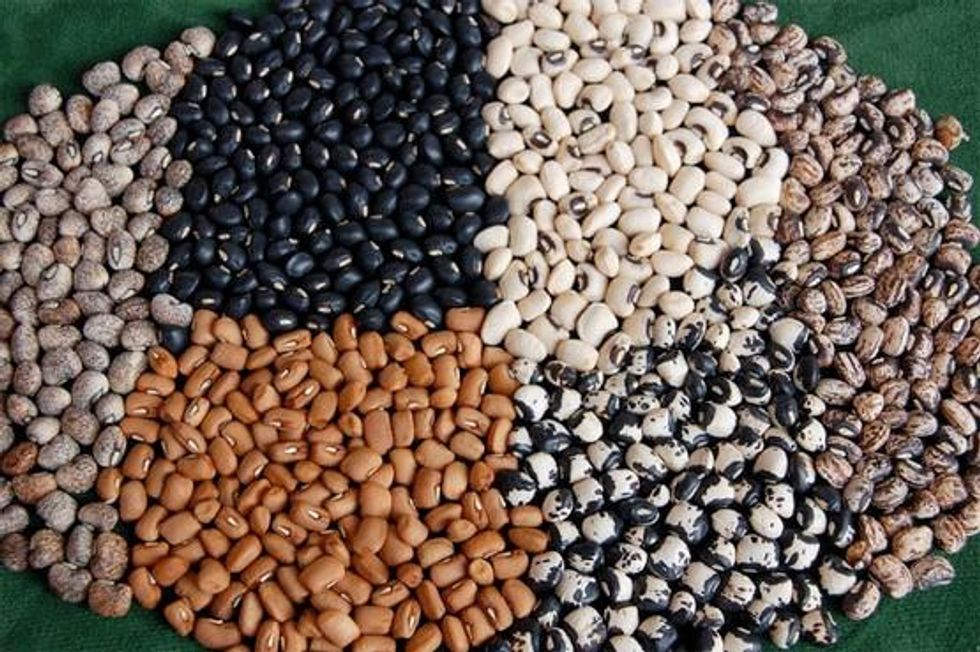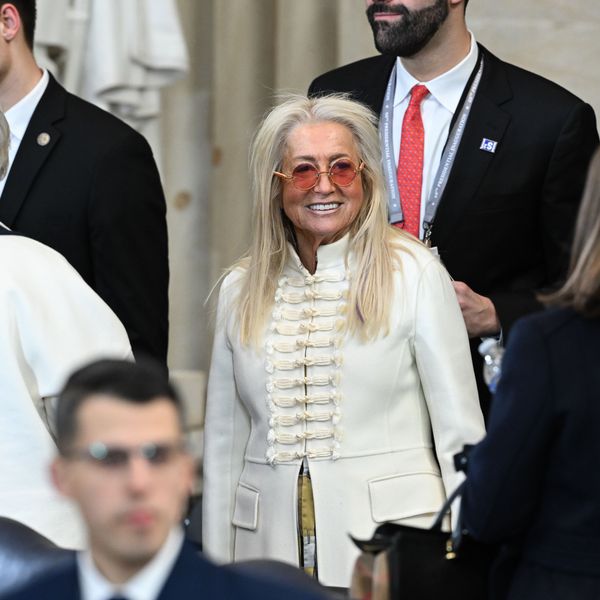Why the Most Powerful Thing in the World is a Seed
“The Seed Underground” is a love letter to the quiet revolutionaries who are saving our food heritage.

Ray begins The Seed Underground: A Growing Revolution to Save Food by explaining how we lost our seeds. Feeding ourselves has always been a burden for humans, she explains. "So when somebody came along and said, 'I'll do that cultivating for you. I'll save the seeds. You do something else,' most of us jumped at the chance to be free."
But, according to Ray, when the dwindling number of farmers who stayed on the land gave up on saving seeds and embraced hybridization, genetically modified organisms, and seed patents in order to make money, we became slaves to multinational corporations like Monsanto and Syngenta, which now control our food supply.
In 2007, 10 companies owned 67 percent of the seed market. These corporations control the playing field, because they influence the government regulators. They've been known to snatch up little-known varieties of seeds, patent them, and demand royalties from farmers whose ancestors have grown the crops for centuries. The result is that our seeds are disappearing, and we miss out on the exquisite tastes and smells of an enormous variety of fruits and vegetables. More alarmingly, "we strip our crops of the ability to adapt to change and we put the entire food supply at risk," Ray writes. "The more varieties we lose, the closer we slide to the tipping point of disaster."
Seeds, it turns out, don't just grow plants--they build stories, heritage, and history, which tend to be shared every time seeds pass from hand to hand.
However, The Seed Underground is not a grim story. It's a story about seeds, after all, which Ray calls "the most hopeful thing in the world." Moreover, it's a story about a handful of quirky, charismatic, "quiet, under-the-radar" revolutionaries, who harvest and stow seeds in the back of refrigerators and freezers across America. Sylvia Davatz, a Vermont gardener who advocates that local food movements produce and promote locally grown seeds, calls herself the Imelda Marcos of seeds, because she has a thousand varieties in her closet. Yanna Fishman, the so-called sweet-potato queen, toils over a wild garden in the highlands of western North Carolina, where she grows 40 varieties of sweet potatoes. Dave Cavagnaro, an Iowan photographer, teaches people to hand-pollinate squash with masking tape to keep vintage varieties pure.
Seeds, it turns out, don't just grow plants--they build stories, heritage, and history, which tend to be shared every time seeds pass from hand to hand. So it's fitting that Ray, an accomplished nature writer and activist, shares some of her own story in The Seed Underground. When she was just a child, Ray got her first heirloom seeds from her grandmother--Jack beans, which resembled eyeballs. At 12 she set a brush fire trying to clear land for a garden. At 22 she joined Seed Savers Exchange.
Perhaps we learn the most about Ray from her present-day gardens at Red Earth, her Georgia farm. Ray writes that in the garden, she is "an animal with a hundred different senses and all of them are switched on." She grows crops like Fife Creek Cowhorn okra, Running Conch cowpea, and Green Glaze collard. Her barn is filled with drying seed heads; her kitchen is stinky with seeds fermenting. "Seeds proliferate in the freezer, in my office, in the seed bank, in the garden shed--in jars, credit card envelopes, coffee cans, medicine bottles, recycled seed packets."
Ray outlines the basics of seed saving in The Seed Underground, but it is not a how-to book. It's a call to action, which often reads like a lyrical love letter to the land and to varieties of squash and peas most of us have never tasted. It's also a love letter to us, Ray's readers. "Even though I may not know you, I have fallen in love with you, you who understand that a relationship to the land is powerful," she writes.
The truth is, Janisse Ray is on a mission to turn you into a quiet, under-the-radar revolutionary, and if you read The Seed Underground, she just might succeed. At the very least, you will look at seeds--tiny, but vital to our survival --differently.
"A seed makes itself. A seed doesn't need a geneticist or hybridist or publicist or matchmaker. But it needs help," she writes. "Sometimes it needs a moth or a wasp or a gust of wind. Sometimes it needs a farm and it needs a farmer. It needs a garden and a gardener. It needs you."
This piece was written for How Cooperatives Are Driving the New Economy, the Spring 2013 issue of YES! Magazine.
An Urgent Message From Our Co-Founder
Dear Common Dreams reader, The U.S. is on a fast track to authoritarianism like nothing I've ever seen. Meanwhile, corporate news outlets are utterly capitulating to Trump, twisting their coverage to avoid drawing his ire while lining up to stuff cash in his pockets. That's why I believe that Common Dreams is doing the best and most consequential reporting that we've ever done. Our small but mighty team is a progressive reporting powerhouse, covering the news every day that the corporate media never will. Our mission has always been simple: To inform. To inspire. And to ignite change for the common good. Now here's the key piece that I want all our readers to understand: None of this would be possible without your financial support. That's not just some fundraising cliche. It's the absolute and literal truth. We don't accept corporate advertising and never will. We don't have a paywall because we don't think people should be blocked from critical news based on their ability to pay. Everything we do is funded by the donations of readers like you. Will you donate now to help power the nonprofit, independent reporting of Common Dreams? Thank you for being a vital member of our community. Together, we can keep independent journalism alive when it’s needed most. - Craig Brown, Co-founder |

Ray begins The Seed Underground: A Growing Revolution to Save Food by explaining how we lost our seeds. Feeding ourselves has always been a burden for humans, she explains. "So when somebody came along and said, 'I'll do that cultivating for you. I'll save the seeds. You do something else,' most of us jumped at the chance to be free."
But, according to Ray, when the dwindling number of farmers who stayed on the land gave up on saving seeds and embraced hybridization, genetically modified organisms, and seed patents in order to make money, we became slaves to multinational corporations like Monsanto and Syngenta, which now control our food supply.
In 2007, 10 companies owned 67 percent of the seed market. These corporations control the playing field, because they influence the government regulators. They've been known to snatch up little-known varieties of seeds, patent them, and demand royalties from farmers whose ancestors have grown the crops for centuries. The result is that our seeds are disappearing, and we miss out on the exquisite tastes and smells of an enormous variety of fruits and vegetables. More alarmingly, "we strip our crops of the ability to adapt to change and we put the entire food supply at risk," Ray writes. "The more varieties we lose, the closer we slide to the tipping point of disaster."
Seeds, it turns out, don't just grow plants--they build stories, heritage, and history, which tend to be shared every time seeds pass from hand to hand.
However, The Seed Underground is not a grim story. It's a story about seeds, after all, which Ray calls "the most hopeful thing in the world." Moreover, it's a story about a handful of quirky, charismatic, "quiet, under-the-radar" revolutionaries, who harvest and stow seeds in the back of refrigerators and freezers across America. Sylvia Davatz, a Vermont gardener who advocates that local food movements produce and promote locally grown seeds, calls herself the Imelda Marcos of seeds, because she has a thousand varieties in her closet. Yanna Fishman, the so-called sweet-potato queen, toils over a wild garden in the highlands of western North Carolina, where she grows 40 varieties of sweet potatoes. Dave Cavagnaro, an Iowan photographer, teaches people to hand-pollinate squash with masking tape to keep vintage varieties pure.
Seeds, it turns out, don't just grow plants--they build stories, heritage, and history, which tend to be shared every time seeds pass from hand to hand. So it's fitting that Ray, an accomplished nature writer and activist, shares some of her own story in The Seed Underground. When she was just a child, Ray got her first heirloom seeds from her grandmother--Jack beans, which resembled eyeballs. At 12 she set a brush fire trying to clear land for a garden. At 22 she joined Seed Savers Exchange.
Perhaps we learn the most about Ray from her present-day gardens at Red Earth, her Georgia farm. Ray writes that in the garden, she is "an animal with a hundred different senses and all of them are switched on." She grows crops like Fife Creek Cowhorn okra, Running Conch cowpea, and Green Glaze collard. Her barn is filled with drying seed heads; her kitchen is stinky with seeds fermenting. "Seeds proliferate in the freezer, in my office, in the seed bank, in the garden shed--in jars, credit card envelopes, coffee cans, medicine bottles, recycled seed packets."
Ray outlines the basics of seed saving in The Seed Underground, but it is not a how-to book. It's a call to action, which often reads like a lyrical love letter to the land and to varieties of squash and peas most of us have never tasted. It's also a love letter to us, Ray's readers. "Even though I may not know you, I have fallen in love with you, you who understand that a relationship to the land is powerful," she writes.
The truth is, Janisse Ray is on a mission to turn you into a quiet, under-the-radar revolutionary, and if you read The Seed Underground, she just might succeed. At the very least, you will look at seeds--tiny, but vital to our survival --differently.
"A seed makes itself. A seed doesn't need a geneticist or hybridist or publicist or matchmaker. But it needs help," she writes. "Sometimes it needs a moth or a wasp or a gust of wind. Sometimes it needs a farm and it needs a farmer. It needs a garden and a gardener. It needs you."
This piece was written for How Cooperatives Are Driving the New Economy, the Spring 2013 issue of YES! Magazine.

Ray begins The Seed Underground: A Growing Revolution to Save Food by explaining how we lost our seeds. Feeding ourselves has always been a burden for humans, she explains. "So when somebody came along and said, 'I'll do that cultivating for you. I'll save the seeds. You do something else,' most of us jumped at the chance to be free."
But, according to Ray, when the dwindling number of farmers who stayed on the land gave up on saving seeds and embraced hybridization, genetically modified organisms, and seed patents in order to make money, we became slaves to multinational corporations like Monsanto and Syngenta, which now control our food supply.
In 2007, 10 companies owned 67 percent of the seed market. These corporations control the playing field, because they influence the government regulators. They've been known to snatch up little-known varieties of seeds, patent them, and demand royalties from farmers whose ancestors have grown the crops for centuries. The result is that our seeds are disappearing, and we miss out on the exquisite tastes and smells of an enormous variety of fruits and vegetables. More alarmingly, "we strip our crops of the ability to adapt to change and we put the entire food supply at risk," Ray writes. "The more varieties we lose, the closer we slide to the tipping point of disaster."
Seeds, it turns out, don't just grow plants--they build stories, heritage, and history, which tend to be shared every time seeds pass from hand to hand.
However, The Seed Underground is not a grim story. It's a story about seeds, after all, which Ray calls "the most hopeful thing in the world." Moreover, it's a story about a handful of quirky, charismatic, "quiet, under-the-radar" revolutionaries, who harvest and stow seeds in the back of refrigerators and freezers across America. Sylvia Davatz, a Vermont gardener who advocates that local food movements produce and promote locally grown seeds, calls herself the Imelda Marcos of seeds, because she has a thousand varieties in her closet. Yanna Fishman, the so-called sweet-potato queen, toils over a wild garden in the highlands of western North Carolina, where she grows 40 varieties of sweet potatoes. Dave Cavagnaro, an Iowan photographer, teaches people to hand-pollinate squash with masking tape to keep vintage varieties pure.
Seeds, it turns out, don't just grow plants--they build stories, heritage, and history, which tend to be shared every time seeds pass from hand to hand. So it's fitting that Ray, an accomplished nature writer and activist, shares some of her own story in The Seed Underground. When she was just a child, Ray got her first heirloom seeds from her grandmother--Jack beans, which resembled eyeballs. At 12 she set a brush fire trying to clear land for a garden. At 22 she joined Seed Savers Exchange.
Perhaps we learn the most about Ray from her present-day gardens at Red Earth, her Georgia farm. Ray writes that in the garden, she is "an animal with a hundred different senses and all of them are switched on." She grows crops like Fife Creek Cowhorn okra, Running Conch cowpea, and Green Glaze collard. Her barn is filled with drying seed heads; her kitchen is stinky with seeds fermenting. "Seeds proliferate in the freezer, in my office, in the seed bank, in the garden shed--in jars, credit card envelopes, coffee cans, medicine bottles, recycled seed packets."
Ray outlines the basics of seed saving in The Seed Underground, but it is not a how-to book. It's a call to action, which often reads like a lyrical love letter to the land and to varieties of squash and peas most of us have never tasted. It's also a love letter to us, Ray's readers. "Even though I may not know you, I have fallen in love with you, you who understand that a relationship to the land is powerful," she writes.
The truth is, Janisse Ray is on a mission to turn you into a quiet, under-the-radar revolutionary, and if you read The Seed Underground, she just might succeed. At the very least, you will look at seeds--tiny, but vital to our survival --differently.
"A seed makes itself. A seed doesn't need a geneticist or hybridist or publicist or matchmaker. But it needs help," she writes. "Sometimes it needs a moth or a wasp or a gust of wind. Sometimes it needs a farm and it needs a farmer. It needs a garden and a gardener. It needs you."
This piece was written for How Cooperatives Are Driving the New Economy, the Spring 2013 issue of YES! Magazine.

